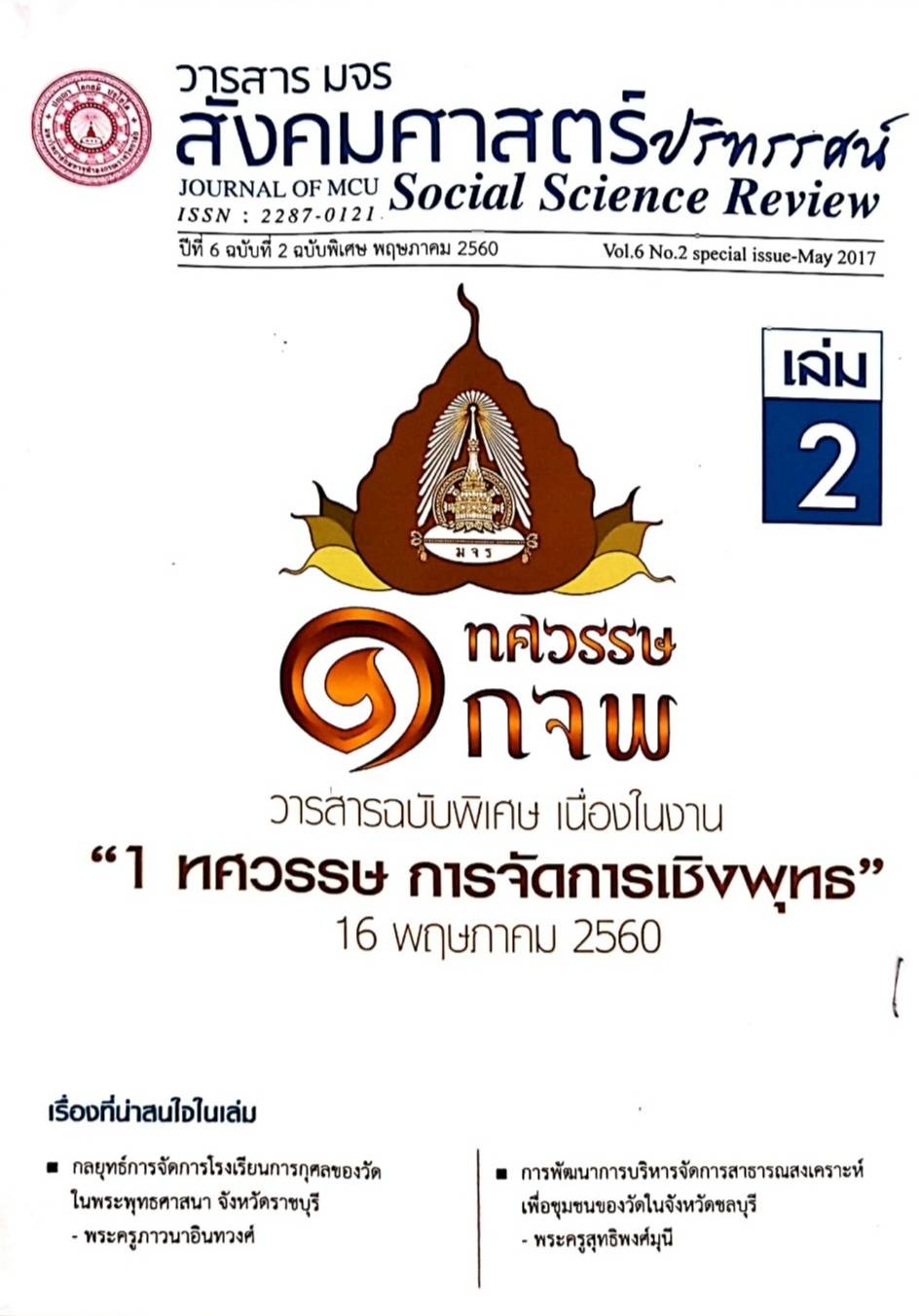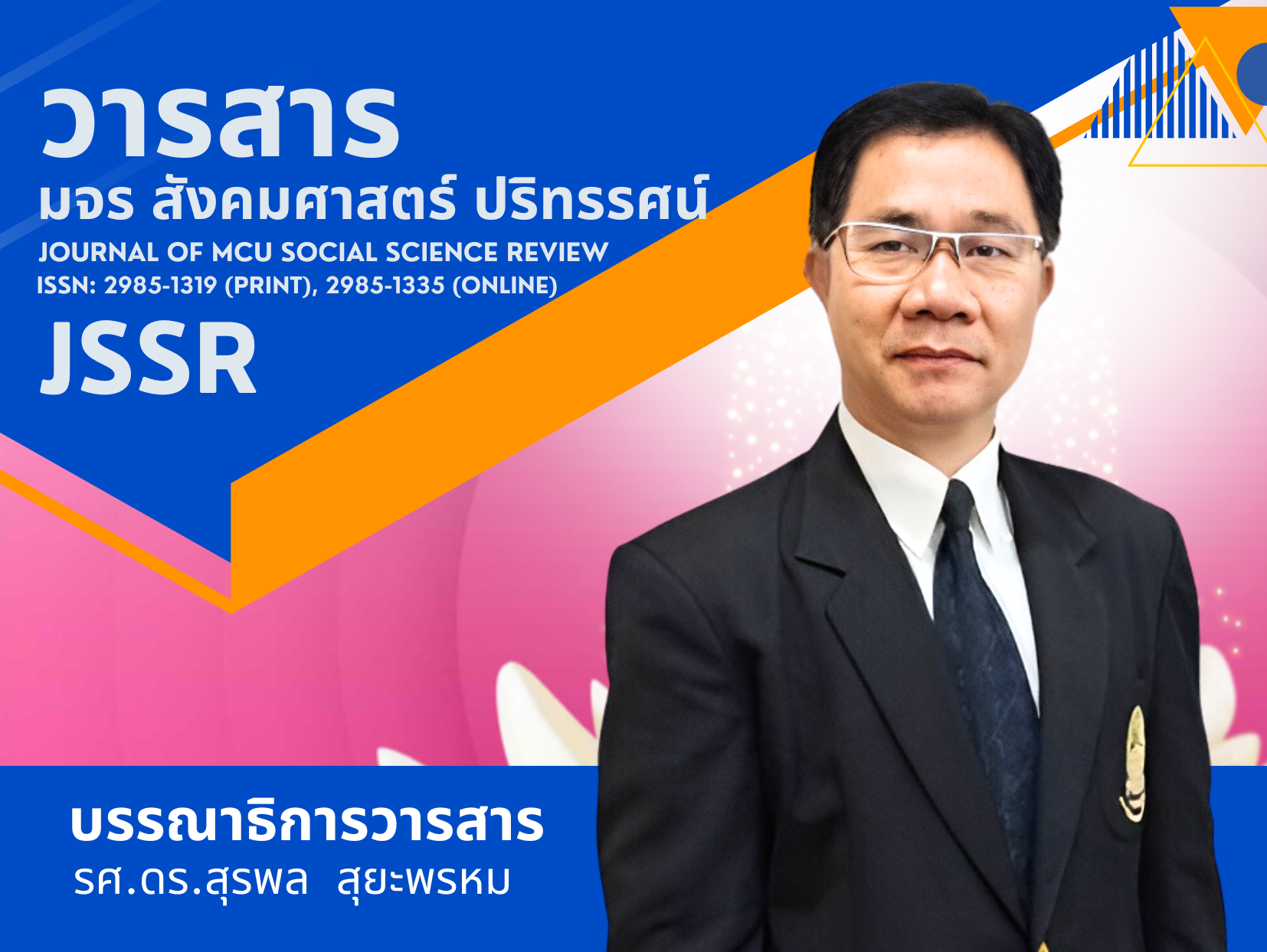BUDDHA INTEGRATION FOR MANAGEMENT IN THE COMMUNITY FOREST AROUND MAE-WONG NATIONAL PARK AREA IN NAKORNSAWAN
Keywords:
community forests; Mae Wong National Park; Principles of Mori DharmaAbstract
This research has 3 main objectives: (1) to study the role of community forests in the way people live and general problems affecting the community forest management around Mae Wong National Park area in Nakornsawan, (2) to study the factors influencing the community forest management around Mae Wong National Park area in Nakornsawan and (3) to present Buddha integration for management in the community forest around Mae Wong National Park area in Nakornsawan. The methodology of this research was mixed methods between qualitative and quantitative methods. 1) the qualitative method collected data from community leaders, monks and government officials responsible for community forest with in-depth interviews of 19 interviewees, data were analyzed by TAC analysis techniques. And focus group 12 expert panelists, data were analyzed by descriptive analysis. 2) the quantitative method collected data from the community forest members around Mae Wong National Park area in Nakornsawan 300 households
with questionnaires and analyzed data by Structural Equation Modeling (SEM).
The results of the research were as follows:
1) the role of community forests in the way people live around Mae Wong
National Park area in Nakornsawan consists of: (1) community forest as a source of food and resources for the community; (2) community forest as a source of income for the community; (3) community forest as a learning center for natural science; and (4) The community forest is a place to relax in the form of ecotourism, and to study the nature of animals and plants. On the problems of community forest
management, the problem of resource management in community forest areas is caused by the forest community members and the community forest administrator. the community forest administrator must provide opportunities and find ways to make the community forest members participate in the management of forest resources in the community forest.
2) The family background, income-based economy and expenditure-based economy are direct influence on the community forest management, statistically significant. The income-based economy has the greatest influence on the community forest management, the family background is based on gender, age, occupation and number of family members influence on the community forest management is close to the expenditure-based economy. At the same time,
applying Principles of Mori Dharma in community forest management has direct influence on the community forest management, statistically significant.
3) Theoretical concepts and principles of Buddhism for community forest management around Mae Wong National Park area in Nakornsawan is Principles of Mori Dharma. There are 7 principles that drive the forest community members to participate in all stages of every process. The Principles of Mori Dharma are (1) frequent meetings (2) a meeting or a meeting And do the work of the collective in unison (3) do not command what is not commanded (4) respect, obey and honor the president group management, and follow the principles prescribed (5) honor the safety of women no persecution (6) respect the worship of pagodas both inside and outside the city, and do not diminish the benefits that have ever nourished those pagodas (7) the protection of justice by God. The community forest around Mae Wong National Park area in Nakornsawan can take Principles of Mori Dharma to apply in integrated with modern management 3 aspects: (1) the resource management, (2) the planning and cooperation management, and (3) the relationships between the community and government agencies management. By limiting the restrictions on community members, all members of the community are involved in the management. It consists of: (1) participation in the search for problems and causes of local problems including community needs, (2) participation in activity planning, (3) involvement in investment and performance, (4) participation in monitoring and evaluation, and (5) participate in the benefits. In addition, in order for sustainable forest communities to live sustainably, communities need to create networking parties from the social sector to help each other. At the same time, all sectors need systematic support.
References
พรเทพ ศรีธนาธร. (มกราคม-มิถุนายน,2556). “นวัตกรรมการจัดการป่าชุมชนท้องถิ่นอย่างยั่งยืน:กลไกการจัดการ การมีส่วนร่วม และความสำเร็จของชุมชนในการอนุรักษ์ป่าชุมชนห้วยแม่หิน จังหวัดลาปาง”. วารสารศรีนครินทรวิโรฒวิจัยและพัฒนา (สาขามนุษยศาสตร์และสังคมศาสตร์), 5(9): 99 – 115.
พระครูปริยัติวิสุทธิคุณ, ผศ.ดร.และคณะ. (2551). “การใช้หลักพุทธศาสนาในการส่งเสริมวิสาหกิจชุมชนพึ่งตนเองลุ่มแม่น้ามูล อาเภอท่าตูม จังหวัดสุรินทร์”. รายงานการวิจัย. บัณฑิตวิทยาลัย : มหาวิทยาลัยมหาจุฬาลงกรณราชวิทยาลัย วิทยาเขตสุรินทร์.
มนูญ หวันหยี. (2550). “บทบาทผู้นำชุมชนการมีผลประโยชน์และการมีส่วนร่วมของชุมชนที่มีผลต่อการยอมรับโครงการพัฒนาพลังงานไฟฟ้าในพื้นที่ภาคใต้ของประเทศไทย ”.วิทยานิพนธ์ปรัชญาดุษฎีบัณฑิต สาขาวิชาการบริหารการพัฒนา. บัณฑิตวิทยาลัย :
มหาวิทยาลัยราชภัฏสวนสุนันทา.
สมชาย โพธิ์ตระกูล. (พฤษภาคม – สิงหาคม, 2558). “การบริหารจัดการการอนุรักษ์ทรัพยากรป่าไม้ในประเทศไทย”, วารสารวิชาการ มหาวิทยาลัยอีสเทิร์นเอเชีย ฉบับสังคมศาสตร์และมนุษศาสตร์, 5(2): 61-75.
สุขุมาลย์ ประสมศักดิ์. (2556). “กลยุทธ์การมีส่วนร่วมของประชาชนในการจัดการสิ่งแวดล้อมตามหลักพุทธธรรมขององค์การบริหารส่วนจังหวัด ในกลุ่มจังหวัดภาคกลางตอนบน”.วิทยานิพนธ์พุทธศาสตรดุษฎีบัณฑิต สาขาวิชารัฐประศาสนศาสตร์. บัณฑิตวิทยาลัย :มหาวิทยาลัยมหาจุฬาลงกรณราชวิทยาลัย.
สุวารีย์ ศรีคา. (2558). “พุทธบูรณาการเพื่อการบริหารจัดการของโรงเรียนฝึกอาชีพกรุงเทพมหานคร”, วิทยานิพนธ์พุทธศาสตรดุษฎีบัณฑิต รัฐประศาสนศาตร์. บัณฑิตวิทยาลัย : มหาวิทยาลัยมหาจุฬาลงกรณราชวิทยาลัย.
อำนวยพร ชลดารงกุล. (2542). “การบริหารจัดการทรัพยากรป่าไม้แบบมีส่วนร่วม: กรณีศึกษาชุมชนบ้านยางโทน อาเภอไทรโยค จังหวัดกาญจนบุรี”. รายงานการวิจัย. สำนักป้องกันรักษาป่าและควบคุมไฟป่า : กรมป่าไม้.
Downloads
Published
How to Cite
Issue
Section
License
Copyright (c) 2020 Journal of MCU Social Science Review

This work is licensed under a Creative Commons Attribution-NonCommercial-NoDerivatives 4.0 International License.
In order to conform the copyright law, all article authors must sign the consignment agreement to transfer the copyright to the Journal including the finally revised original articles. Besides, the article authors must declare that the articles will be printed in only the Journal of MCU Journal of Social Sciences. If there are pictures, tables or contents that were printed before, the article authors must receive permission from the authors in writing and show the evidence to the editor before the article is printed. If it does not conform to the set criteria, the editor will remove the article from the Journal without any exceptions.




